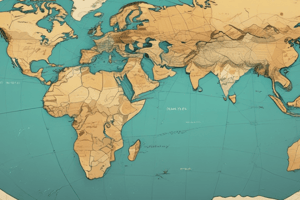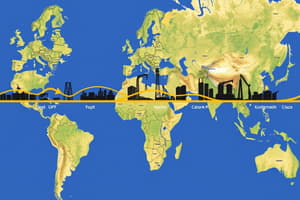Podcast
Questions and Answers
What is the estimated number of international migrants between 1970 and 2020, according to IOM?
What is the estimated number of international migrants between 1970 and 2020, according to IOM?
- 84 million to 281 million (correct)
- 150 million to 300 million
- 200 million to 400 million
- 100 million to 200 million
What is the percentage of the population that is comprised of international migrants?
What is the percentage of the population that is comprised of international migrants?
- 3.60% of the population (correct)
- 7.20% of the population
- 5.10% of the population
- 1.20% of the population
What is the main reason for people to seek better living conditions through migration?
What is the main reason for people to seek better living conditions through migration?
- Poverty and unemployment
- Socio-economic inequalities (correct)
- Wars and conflicts
- Environmental disasters
What is the estimated number of migrant workers, according to ILO?
What is the estimated number of migrant workers, according to ILO?
What is the term for migration that is linked to fragility and often arises from poverty, wars, or natural disasters?
What is the term for migration that is linked to fragility and often arises from poverty, wars, or natural disasters?
What is the term for migration that involves people fleeing their hometown due to war, persecution, environmental disaster, or dearth?
What is the term for migration that involves people fleeing their hometown due to war, persecution, environmental disaster, or dearth?
What is the term for a complex migratory population movement including refugees, asylum seekers, and economic migrants?
What is the term for a complex migratory population movement including refugees, asylum seekers, and economic migrants?
What is a push factor that drives migration?
What is a push factor that drives migration?
What is the term for someone who has been forced to flee their country due to persecution, war, or violence?
What is the term for someone who has been forced to flee their country due to persecution, war, or violence?
How many asylum seekers were granted protection by the EU in 2022?
How many asylum seekers were granted protection by the EU in 2022?
What is the main reason why a refugee cannot return home?
What is the main reason why a refugee cannot return home?
What is the primary difference between a refugee and an internally displaced person (IDP)?
What is the primary difference between a refugee and an internally displaced person (IDP)?
What is an environmental migrant?
What is an environmental migrant?
What is a push factor that influences migration?
What is a push factor that influences migration?
What is the primary reason why asylum seekers are not automatically recognized as refugees?
What is the primary reason why asylum seekers are not automatically recognized as refugees?
What is the main demographic influence on migration?
What is the main demographic influence on migration?
What is a common pull factor that influences migration?
What is a common pull factor that influences migration?
What is the primary reason why the Lampedusa case is significant in terms of migration?
What is the primary reason why the Lampedusa case is significant in terms of migration?
What is a common consequence of the 'needy state' of migrants?
What is a common consequence of the 'needy state' of migrants?
What is the main reason why migrants and asylum seekers often choose to cross the Central Mediterranean route?
What is the main reason why migrants and asylum seekers often choose to cross the Central Mediterranean route?
What is the definition of a migrant according to the International Organization for Migration (IOM)?
What is the definition of a migrant according to the International Organization for Migration (IOM)?
What is considered an example of internal migration?
What is considered an example of internal migration?
According to the European Commission, what is the definition of a migrant?
According to the European Commission, what is the definition of a migrant?
What is the definition of an international migrant according to the United Nations?
What is the definition of an international migrant according to the United Nations?
What is the main difference between the IOM and European Commission definitions of a migrant?
What is the main difference between the IOM and European Commission definitions of a migrant?
What is a common theme among the definitions of a migrant from the IOM, European Commission, and UN?
What is a common theme among the definitions of a migrant from the IOM, European Commission, and UN?
Flashcards are hidden until you start studying
Study Notes
International Migration Trends
- The total number of international migrants increased from 84 million in 1970 to 281 million in 2020, representing 3.60% of the global population.
Categories of Migratory Flows
- There are three main types of migration: voluntary, forced, and "mixed" type.
- According to ILO, in 2022, there were 150 million migrant workers and 5 million international students.
Forced Migration
- Forced migration occurs when people are forced to leave their homes due to war, persecution, environmental disasters, or famine.
- According to UNHCR, in 2022, 384,245 asylum seekers were granted protection in the EU, a 40% increase from the previous year.
Mixed Migration
- Mixed migration refers to a complex migratory population movement including refugees, asylum seekers, economic migrants, and other types of migrants.
- This type of migration is often illegal and can be linked to human smuggling.
Push and Pull Factors
- Push factors: reasons that individuals might emigrate from their country, including socio-political, economic, and environmental factors.
- Pull factors: reasons that an individual might choose a particular country, including better healthcare, education, and social services.
Socio-Political Factors
- Socio-political causes of migration can include persecution, war, and better healthcare, education, and social services.
- Most people who emigrate for socio-political reasons can be defined as refugees or humanitarian migrants.
Refugee, IDP, and Asylum-Seeker Definitions
- Refugee: someone who has been forced to flee their country due to persecution, war, or violence.
- IDP (Internally Displaced Person): someone who has been forced to flee their home but has not crossed an international border.
- Asylum-seeker: someone who is seeking international protection.
Demographic and Economic Factors
- Demographic factors: aging or excessive population growth can influence the choice to leave one's country.
- Economic factors: poor labor standards, high unemployment, and the overall health of a country's economy can push people to migrate.
Environmental Factors
- Environmental migrants: persons or groups of persons who are forced to leave their homes due to environmental changes that affect their lives or living conditions.
- Examples of environmental factors include sea-level rise, drought, floods, cyclones, and earthquakes.
Migration Flows to EU and Migration Routes
- The Central Mediterranean route is a major pathway for migrants and asylum seekers to reach Italy and Malta from sub-Saharan Africa and North Africa.
- The number of irregular migrants along this route has increased significantly since 2020.
Lampedusa Case
- Lampedusa is a gateway to Europe for migrants, with over 12,000 migrants arriving in 2022.
- The island is closer to Africa than Sicily, making it a common route for migrants.
Studying That Suits You
Use AI to generate personalized quizzes and flashcards to suit your learning preferences.




